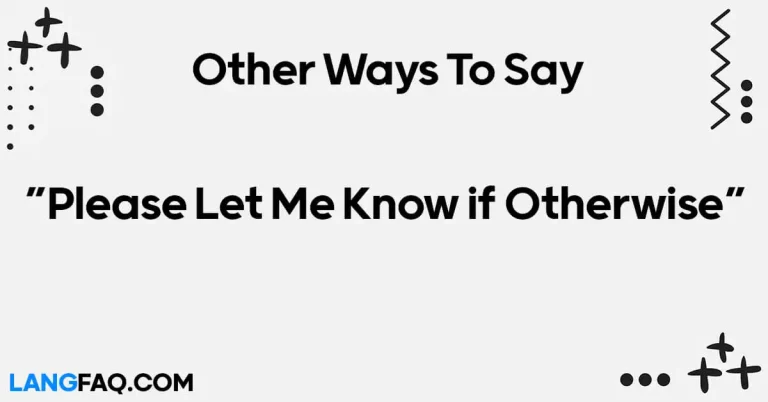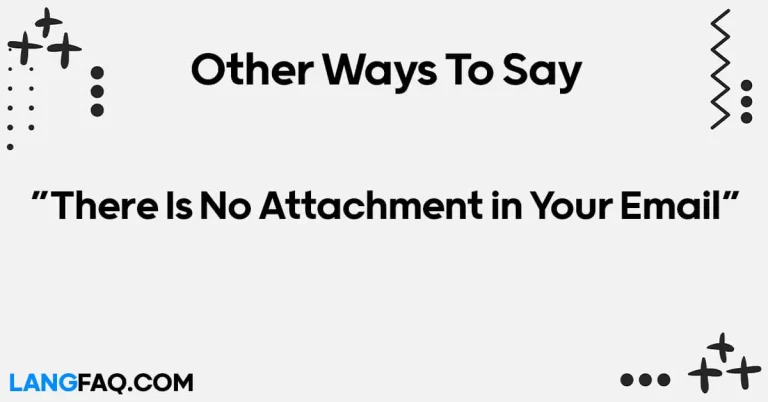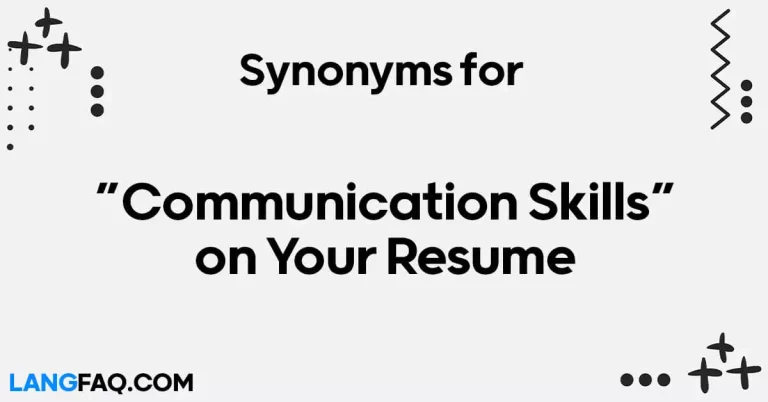Communication is the cornerstone of effective relationships, whether personal or professional. In the realm of workplace communication, a gentle reminder can often be the catalyst for action. However, relying on the same phrase repeatedly can lead to monotony and disengagement. Hence, it’s essential to diversify your linguistic repertoire. In this article, we’ll explore 12 alternative phrases to “just a friendly reminder” that can infuse your communication with warmth and professionalism.
12 Other Ways to Say “Just a Friendly Reminder”
Here are 12 alternative ways to say “Just a Friendly Reminder”:
- A Gentle Nudge
- A Polite Heads-Up
- A Cordial Reminder
- A Kind Prompt
- A Courteous Nudge
- A Friendly Heads-Up
- A Pleasant Reminder
- A Gentle Prompt
- A Considerate Nudge
- A Warm Reminder
- A Respectful Heads-Up
- A Kindly Prompt
Here’s the table with meanings and examples:
| Alternative Phrase | Meaning | Example |
|---|---|---|
| A Gentle Nudge | A subtle reminder or suggestion | “Just a gentle nudge to submit your report by Friday.” |
| A Polite Heads-Up | A courteous notification or warning | “I wanted to give you a polite heads-up about the upcoming meeting.” |
| A Cordial Reminder | A friendly and respectful prompt | “This is just a cordial reminder to RSVP for the event.” |
| A Kind Prompt | A considerate and gentle reminder | “May I offer a kind prompt to review the document before our meeting?” |
| A Courteous Nudge | A polite and respectful encouragement | “Could I provide a courteous nudge to finalize your project proposal?” |
| A Friendly Heads-Up | A warm and amiable notification | “I thought I’d give you a friendly heads-up about the schedule change.” |
| A Pleasant Reminder | An enjoyable and agreeable prompt | “Consider this a pleasant reminder to complete your training module.” |
| A Gentle Prompt | A soft and delicate suggestion | “Just a gentle prompt to double-check your calculations.” |
| A Considerate Nudge | A thoughtful and caring reminder | “Allow me to offer a considerate nudge to review the safety protocols.” |
| A Warm Reminder | A heartfelt and encouraging prompt | “Here’s a warm reminder to celebrate your team’s achievements.” |
| A Respectful Heads-Up | A dignified and considerate notification | “I wanted to provide a respectful heads-up regarding the project deadline.” |
| A Kindly Prompt | A gentle and compassionate reminder | “I’d like to offer a kindly prompt to acknowledge your colleague’s efforts.” |
By incorporating these alternative phrases into your communication, you can convey reminders and prompts with warmth, respect, and consideration. Using varied language not only keeps interactions fresh but also fosters positive relationships and encourages cooperation.
Is It Correct to Say “Just a Friendly Reminder”?
Yes, “Just a friendly reminder” is a common and appropriate phrase used to gently prompt someone’s memory or attention in a friendly and non-intrusive manner. This phrase is often used in both formal and informal contexts to convey a message without causing offense or discomfort. It implies that the reminder is offered with goodwill and kindness, emphasizing the friendly nature of the communication. However, it’s essential to ensure that the tone and context are appropriate for the situation in which you’re using this phrase.
Professional Mail Example With “Just a Friendly Reminder”
Subject: Just a Friendly Reminder: Upcoming Deadline
Dear [Recipient’s Name],
I hope this email finds you well. I wanted to send you a quick reminder regarding the upcoming deadline for [specific task or project]. As discussed in our previous meeting, the deadline for [task/project] is [date].
Just a friendly reminder to ensure that all necessary preparations and final touches are completed by the deadline. Your contributions to this project are invaluable, and I have full confidence in your abilities to deliver outstanding results.
Should you have any questions or require any assistance, please don’t hesitate to reach out. I’m here to support you every step of the way.
Thank you for your attention to this matter, and I look forward to seeing the successful outcome of your hard work.
Best regards,
[Your Name] [Your Position/Title] [Your Contact Information]
A Gentle Nudge
A gentle nudge is like a soft tap on the shoulder, gently prompting someone to take action without imposing or pressuring them. It’s a subtle way to remind someone of a task or deadline while maintaining a friendly and non-intrusive tone.
Definition and Usage:
According to the Cambridge Dictionary, a nudge is “a gentle push or hit, especially with the elbow, to get someone’s attention, show them something, or make them move.” In communication, a gentle nudge serves a similar purpose—it draws attention to a specific matter without being forceful.
When to Use:
You can use a gentle nudge in various situations, whether you’re reminding a colleague about a pending task or prompting a friend to follow through on a commitment. It’s particularly useful in scenarios where you want to convey a sense of care and consideration without appearing pushy.
Example Scenario:
Formal Context: Colleague A: “Just a gentle nudge, but don’t forget about the budget report due tomorrow.”
Informal Context: Friend A: “Hey, just a gentle nudge to RSVP for Sarah’s birthday party next week.”
Email Sample:
Subject: Friendly Reminder: Budget Report Due Tomorrow
Hi [Colleague’s Name],
I hope this email finds you well. Just a gentle nudge to remind you about the budget report that’s due tomorrow. Let me know if you need any assistance or clarification.
Best regards, [Your Name]
Variations:
- A Soft Reminder
- A Subtle Nudge
- A Gentle Tap
Pros:
- Maintains a friendly tone
- Doesn’t come across as pushy
- Encourages cooperation and collaboration
Cons:
- May be overlooked if not emphasized enough
- Requires clarity to ensure the recipient understands the importance of the reminder
Tips:
- Keep the language polite and respectful
- Provide context to ensure clarity
- Follow up if necessary to ensure the message is received and understood
A Polite Heads-Up
A polite heads-up is akin to giving someone a friendly warning or notification in advance, allowing them to prepare or take necessary action without feeling caught off guard. It’s a courteous way to inform someone of upcoming events or changes.
Definition and Usage:
The term “heads-up” originated from aviation, referring to a warning or alert given to pilots about potential hazards. In everyday communication, a polite heads-up serves a similar purpose—it alerts the recipient to something important or impending in a courteous manner.
When to Use:
Use a polite heads-up when you want to inform someone about a forthcoming event, deadline, or change without causing alarm or stress. It’s especially useful in professional settings where clarity and courtesy are paramount.
Example Scenario:
Formal Context: Manager: “Just a polite heads-up, the client meeting has been rescheduled to 3:00 PM.”
Informal Context: Friend: “Hey, just a heads-up, but the movie starts at 7:30 tonight, not 8:00.”
Email Sample:
Subject: Heads-Up: Change in Meeting Schedule
Hi [Recipient’s Name],
I wanted to give you a polite heads-up that the client meeting scheduled for tomorrow has been rescheduled to 3:00 PM. Please let me know if this timing works for you or if we need to make any adjustments.
Best regards, [Your Name]
Variations:
- A Friendly Alert
- A Courteous Notification
- A Gentle Warning
Pros:
- Shows consideration for the recipient
- Helps prevent confusion or misunderstandings
- Encourages proactive behavior
Cons:
- May require follow-up to ensure the message is received and understood
- Should be used sparingly to avoid overloading the recipient with notifications
Tips:
- Be clear and concise in your communication
- Provide any necessary context or background information
- Offer assistance or support if needed
A Cordial Reminder
A cordial reminder is a friendly and respectful prompt intended to gently draw someone’s attention to a matter without causing offense or discomfort. It emphasizes warmth and goodwill in communication, fostering positive relationships.
Definition and Usage:
The term “cordial” implies warmth, friendliness, and sincerity. A cordial reminder reflects these qualities, conveying your message in a polite and respectful manner while maintaining a pleasant demeanor.
When to Use:
Use a cordial reminder when you want to communicate with kindness and consideration, especially in situations where the recipient may need a gentle nudge. It’s suitable for both professional and personal contexts where maintaining positive rapport is important.
Example Scenario:
Formal Context: Supervisor: “Just a cordial reminder, the project deadline is approaching, so please ensure all tasks are completed on time.”
Informal Context: Family Member: “Hey, just a cordial reminder to RSVP for Grandma’s birthday dinner by Friday.”
Email Sample:
Subject: Cordial Reminder: Project Deadline
Hi [Recipient’s Name],
I hope you’re doing well. I wanted to send you a cordial reminder that the deadline for the project is fast approaching. Please let me know if you need any assistance or if there’s anything I can do to help ensure we meet our goals on time.
Best regards, [Your Name]
Variations:
- A Friendly Reminder
- A Pleasant Nudge
- A Kindly Alert
Pros:
- Demonstrates respect and consideration
- Helps maintain positive relationships
- Encourages responsiveness without pressure
Cons:
- May be perceived as overly casual in certain formal contexts
- Requires clarity to ensure the message is understood correctly
Tips:
- Use a warm and friendly tone
- Acknowledge the recipient’s efforts or contributions
- Offer support or assistance if needed
A Kind Prompt
A kind prompt is a gentle and compassionate reminder designed to encourage action with empathy and understanding. It acknowledges the recipient’s needs and priorities while motivating them to take necessary steps.
Definition and Usage:
Kindness involves compassion, empathy, and consideration for others’ feelings. A kind prompt embodies these qualities, conveying your message in a supportive and encouraging manner to inspire cooperation and collaboration.
When to Use:
Use a kind prompt when you want to convey your message with empathy and understanding, particularly in situations where the recipient may be feeling overwhelmed or stressed. It’s effective in both professional and personal contexts where maintaining a positive relationship is essential.
Example Scenario:
Formal Context: Mentor: “May I offer a kind prompt to review the proposal before our meeting tomorrow?”
Informal Context: Friend: “Hey, just a kind prompt, but don’t forget to take breaks and prioritize self-care during this busy time.”
Email Sample:
Subject: A Kind Prompt: Proposal Review
Hi [Recipient’s Name],
I hope you’re doing well. I wanted to offer a kind prompt to remind you to review the proposal before our meeting tomorrow. Your insights and feedback are invaluable, and I appreciate your attention to detail.
Best regards, [Your Name]
Variations:
- A Gentle Reminder
- A Compassionate Nudge
- A Caring Alert
Pros:
- Demonstrates empathy and understanding
- Fosters a supportive and positive environment
- Encourages collaboration and cooperation
Cons:
- May be perceived as overly familiar in certain formal settings
- Requires sensitivity to the recipient’s emotions and needs
Tips:
- Use language that conveys sincerity and care
- Acknowledge the recipient’s efforts or challenges
- Offer assistance or support if needed
A Courteous Nudge
A courteous nudge is a polite and respectful encouragement to prompt action without causing discomfort or offense. It emphasizes consideration and professionalism in communication, fostering positive interactions.
Definition and Usage:
Courtesy involves politeness, respect, and consideration for others’ feelings. A courteous nudge embodies these qualities, conveying your message in a dignified and respectful manner while encouraging the recipient to take necessary steps.
When to Use:
Use a courteous nudge when you want to motivate someone to act without exerting pressure or causing discomfort. It’s suitable for various contexts, including professional environments, where maintaining decorum and professionalism is important.
Example Scenario:
Formal Context: Manager: “Could I provide a courteous nudge to finalize your project proposal by the end of the day?”
Informal Context: Friend: “Hey, just a courteous nudge, but don’t forget to submit your application before the deadline.”
Email Sample:
Subject: Courteous Nudge: Project Proposal
Hi [Recipient’s Name],
I hope this email finds you well. I wanted to provide a courteous nudge to remind you about the deadline for finalizing the project proposal. Your contributions are integral to our success, and I appreciate your attention to detail.
Best regards, [Your Name]
Variations:
- A Polite Reminder
- A Respectful Prompt
- A Considerate Alert
Pros:
- Demonstrates professionalism and respect
- Encourages responsiveness without pressure
- Fosters positive relationships and cooperation
Cons:
- May be perceived as overly formal in certain informal settings
- Requires clarity to ensure the message is understood correctly
Tips:
- Use language that conveys respect and consideration
- Acknowledge the recipient’s contributions or efforts
- Offer assistance or support if needed
A Friendly Heads-Up
A friendly heads-up is a warm and amiable notification intended to inform someone of upcoming events or changes in a positive and upbeat manner. It emphasizes camaraderie and goodwill in communication, fostering a sense of collaboration.
Definition and Usage:
A heads-up is an alert or warning given in advance to help someone prepare for or anticipate a situation. A friendly heads-up adds warmth and friendliness to this concept, conveying your message in a cheerful and approachable manner.
When to Use:
Use a friendly heads-up when you want to communicate upcoming events, changes, or deadlines in a positive and supportive way. It’s effective in both professional and personal contexts, where maintaining a positive rapport is important.
Example Scenario:
Formal Context: Team Leader: “Hey, just a friendly heads-up, but the weekly meeting has been moved to 10:00 AM tomorrow.”
Informal Context: Friend: “Just a heads-up, but the concert starts at 8:00, not 8:30 as we thought.”
Email Sample:
Subject: Friendly Heads-Up: Weekly Meeting Schedule Change
Hi [Recipient’s Name],
I hope you’re having a great day. Just a friendly heads-up to let you know that the weekly meeting has been moved to 10:00 AM tomorrow. Looking forward to your insights and contributions as always.
Best regards, [Your Name]
Variations:
- A Cheerful Alert
- A Positive Reminder
- A Happy Nudge
Pros:
- Creates a positive and upbeat atmosphere
- Fosters camaraderie and cooperation
- Encourages proactive behavior without pressure
Cons:
- May be perceived as overly casual in certain formal settings
- Requires clarity to ensure the message is understood correctly
Tips:
- Use language that conveys warmth and positivity
- Acknowledge the recipient’s contributions or efforts
- Offer assistance or support if needed
A Pleasant Reminder
A pleasant reminder is an enjoyable and agreeable prompt designed to gently draw someone’s attention to a matter with positivity and encouragement. It emphasizes friendliness and appreciation in communication, fostering a sense of mutual respect.
Definition and Usage:
The term “pleasant” denotes something that is enjoyable, agreeable, and satisfying. A pleasant reminder embodies these qualities, conveying your message in a cheerful and uplifting manner while motivating the recipient to take necessary action.
When to Use:
Use a pleasant reminder when you want to convey your message with warmth and positivity, particularly in situations where the recipient may need a gentle nudge. It’s suitable for both professional and personal contexts, where maintaining a positive relationship is essential.
Example Scenario:
Formal Context: Supervisor: “Consider this a pleasant reminder to submit your expense reports by the end of the week.”
Informal Context: Family Member: “Hey, just a pleasant reminder, but don’t forget about our dinner plans tonight.”
Email Sample:
Subject: A Pleasant Reminder: Expense Reports
Hi [Recipient’s Name],
I hope you’re doing well. Just a pleasant reminder to submit your expense reports by the end of the week. Your attention to detail is greatly appreciated, and I’m here to assist if you need any support.
Best regards, [Your Name]
Variations:
- An Enjoyable Nudge
- A Delightful Alert
- A Joyful Prompt
Pros:
- Creates a positive and uplifting atmosphere
- Fosters mutual respect and appreciation
- Encourages responsiveness with enthusiasm
Cons:
- May be perceived as overly informal in certain formal settings
- Requires clarity to ensure the message is understood correctly
Tips:
- Use language that conveys happiness and satisfaction
- Acknowledge the recipient’s efforts or contributions
- Offer assistance or support if needed
A Gentle Prompt
A gentle prompt is a soft and delicate suggestion intended to encourage action without exerting pressure or causing discomfort. It emphasizes subtlety and consideration in communication, fostering cooperation and understanding.
Definition and Usage:
A prompt is a reminder or cue to take action, while “gentle” implies softness, delicacy, and sensitivity. A gentle prompt combines these qualities, conveying your message in a gentle and non-intrusive manner while motivating the recipient to act.
When to Use:
Use a gentle prompt when you want to prompt someone to take action with kindness and consideration, particularly in situations where the recipient may be feeling overwhelmed or stressed. It’s effective in both professional and personal contexts, where maintaining positive rapport is important.
Example Scenario:
Formal Context: Manager: “Just a gentle prompt, but could you please review the presentation slides before the meeting?”
Informal Context: Friend: “Hey, just a gentle prompt, but don’t forget to call your mom on her birthday.”
Email Sample:
Subject: A Gentle Prompt: Presentation Review
Hi [Recipient’s Name],
I trust you’re doing well. Just a gentle prompt to remind you to review the presentation slides before our meeting tomorrow. Your insights are invaluable, and I appreciate your attention to detail.
Best regards, [Your Name]
Variations:
- A Soft Reminder
- A Subtle Nudge
- A Tender Alert
Pros:
- Demonstrates sensitivity and consideration
- Encourages responsiveness without pressure
- Fosters positive relationships and cooperation
Cons:
- May be perceived as overly cautious in certain informal settings
- Requires clarity to ensure the message is understood correctly
Tips:
- Use language that conveys gentleness and kindness
- Acknowledge the recipient’s contributions or efforts
- Offer assistance or support if needed
A Considerate Nudge
A considerate nudge is a thoughtful and caring reminder designed to prompt action with empathy and understanding. It emphasizes consideration for the recipient’s feelings and priorities, fostering a sense of mutual respect.
Definition and Usage:
Consideration involves thoughtfulness, empathy, and sensitivity to others’ needs. A considerate nudge embodies these qualities, conveying your message in a caring and supportive manner while motivating the recipient to take necessary steps.
When to Use:
Use a considerate nudge when you want to prompt someone to act with empathy and understanding, particularly in situations where the recipient may be facing challenges or difficulties. It’s effective in both professional and personal contexts, where maintaining positive rapport is important.
Example Scenario:
Formal Context: Mentor: “Allow me to offer a considerate nudge to review the safety protocols before the inspection next week.”
Informal Context: Friend: “Just a considerate nudge, but don’t forget to take breaks and prioritize self-care during this busy time.”
Email Sample:
Subject: A Considerate Nudge: Safety Protocols Review
Hi [Recipient’s Name],
I hope this email finds you well. I wanted to offer a considerate nudge to remind you to review the safety protocols before the inspection next week. Your well-being is important, and I’m here to support you in any way I can.
Best regards, [Your Name]
Variations:
- A Thoughtful Reminder
- A Compassionate Nudge
- A Caring Alert
Pros:
- Demonstrates empathy and understanding
- Fosters a supportive and positive environment
- Encourages collaboration and cooperation
Cons:
- May be perceived as overly cautious in certain informal settings
- Requires sensitivity to the recipient’s emotions and needs
Tips:
- Use language that conveys care and concern
- Acknowledge the recipient’s challenges or difficulties
- Offer assistance or support if needed
A Warm Reminder
A warm reminder is a heartfelt and encouraging prompt designed to prompt action with kindness and positivity. It emphasizes warmth and sincerity in communication, fostering a sense of trust and appreciation.
Definition and Usage:
Warmth involves friendliness, sincerity, and genuine concern for others’ well-being. A warm reminder embodies these qualities, conveying your message in a supportive and uplifting manner while motivating the recipient to take necessary steps.
When to Use:
Use a warm reminder when you want to prompt someone to act with kindness and positivity, particularly in situations where the recipient may benefit from encouragement and support. It’s effective in both professional and personal contexts, where maintaining positive rapport is important.
Example Scenario:
Formal Context: Team Leader: “Here’s a warm reminder to celebrate your team’s achievements and acknowledge their hard work.”
Informal Context: Family Member: “Hey, just a warm reminder, but I’m always here for you if you need someone to talk to.”
Email Sample:
Subject: A Warm Reminder: Team Appreciation
Hi [Recipient’s Name],
I hope you’re doing well. Here’s a warm reminder to take a moment to celebrate your team’s achievements and acknowledge their hard work. Your leadership and support are greatly appreciated.
Best regards, [Your Name]
Variations:
- A Heartfelt Nudge
- A Supportive Alert
- A Kind Reminder
Pros:
- Creates a positive and uplifting atmosphere
- Fosters mutual respect and appreciation
- Encourages responsiveness with enthusiasm
Cons:
- May be perceived as overly emotional in certain formal settings
- Requires clarity to ensure the message is understood correctly
Tips:
- Use language that conveys sincerity and encouragement
- Acknowledge the recipient’s efforts or contributions
- Offer assistance or support if needed
A Respectful Heads-Up
A respectful heads-up is a dignified and considerate notification intended to inform someone of upcoming events or changes in a manner that preserves their dignity and respect. It emphasizes professionalism and courtesy in communication, fostering positive relationships.
Definition and Usage:
Respect involves regard, esteem, and consideration for others’ feelings and rights. A respectful heads-up embodies these qualities, conveying your message in a manner that acknowledges the recipient’s dignity and autonomy while providing necessary information or alerts.
When to Use:
Use a respectful heads-up when you want to inform someone of upcoming events, changes, or deadlines in a manner that respects their autonomy and dignity. It’s effective in professional settings where maintaining professionalism and courtesy is important.
Example Scenario:
Formal Context: Manager: “I wanted to provide a respectful heads-up regarding the project deadline extension to ensure everyone has ample time to adjust their schedules accordingly.”
Informal Context: Friend: “Just a heads-up, but I wanted to let you know that I’ll be arriving 15 minutes late to dinner tonight.”
Email Sample:
Subject: Respectful Heads-Up: Project Deadline Extension
Hi [Recipient’s Name],
I trust this email finds you well. I wanted to provide a respectful heads-up regarding the project deadline extension. Please take this opportunity to adjust your schedules accordingly, and feel free to reach out if you have any questions or concerns.
Best regards, [Your Name]
Variations:
- A Considerate Alert
- A Dignified Reminder
- A Tactful Heads-Up
Pros:
- Demonstrates professionalism and courtesy
- Fosters mutual respect and understanding
- Encourages proactive planning and adjustment
Cons:
- May be perceived as overly formal in certain informal settings
- Requires clarity to ensure the message is understood correctly
Tips:
- Use language that conveys respect and consideration
- Acknowledge the recipient’s autonomy and rights
- Offer assistance or support if needed
A Kindly Prompt
A kindly prompt is a gentle and compassionate reminder designed to encourage action with kindness and understanding. It emphasizes empathy and care in communication, fostering positive interactions and relationships.
Definition and Usage:
Kindness involves compassion, generosity, and consideration for others’ feelings and needs. A kindly prompt embodies these qualities, conveying your message in a manner that encourages cooperation and understanding while respecting the recipient’s feelings and autonomy.
When to Use:
Use a kindly prompt when you want to prompt someone to take action with empathy and care, particularly in situations where the recipient may be facing challenges or difficulties. It’s effective in both professional and personal contexts, where maintaining positive rapport is important.
Example Scenario:
Formal Context: Mentor: “May I offer a kindly prompt to prioritize self-care and well-being during this busy period of project deadlines?”
Informal Context: Friend: “Hey, just a kindly prompt, but don’t forget to take breaks and recharge when you need to.”
Email Sample:
Subject: A Kindly Prompt: Self-Care Reminder
Hi [Recipient’s Name],
I hope you’re doing well. May I offer a kindly prompt to prioritize self-care and well-being during this busy period of project deadlines? Your health and happiness are important, and I’m here to support you in any way I can.
Best regards, [Your Name]
Variations:
- A Compassionate Nudge
- A Gentle Reminder
- A Supportive Alert
Pros:
- Demonstrates empathy and care
- Fosters a supportive and positive environment
- Encourages collaboration and cooperation
Cons:
- May be perceived as overly familiar in certain formal settings
- Requires sensitivity to the recipient’s emotions and needs
Tips:
- Use language that conveys kindness and understanding
- Acknowledge the recipient’s challenges or difficulties
- Offer assistance or support if needed
Frequently Asked Questions (FAQs)
What are some other ways to say “just a friendly reminder”? There are several alternatives, including “a quick heads-up,” “a polite reminder,” and “a gentle prompt.”
Why is it important to vary communication phrases? Varying communication phrases helps prevent monotony and keeps your message fresh and engaging.
How can I politely remind someone without using the phrase “just a friendly reminder”? You can use phrases like “a kind reminder” or “a courteous prompt” to convey your message politely.
Are there cultural considerations when using alternative phrases? Yes, it’s essential to consider cultural nuances and sensitivities when choosing alternative phrases.
Can using different phrases improve workplace communication? Yes, using varied phrases can enhance workplace communication by keeping interactions lively and engaging.
How do I know which alternative phrase to use in a given situation? Consider the context, audience, and desired tone when selecting alternative phrases for communication.
Conclusion
In conclusion, diversifying your communication repertoire with alternative phrases to “just a friendly reminder” can enhance your effectiveness as a communicator. By choosing words that convey warmth, respect, and professionalism, you can foster positive relationships and prompt action with ease.







